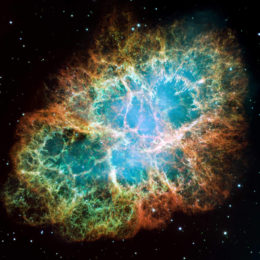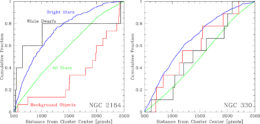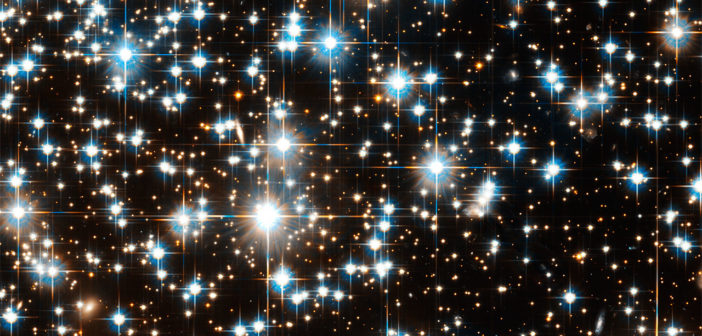
Hubble Space Telescope image of the Crab Nebula, the remnant of a supernova that took place in the year 1054 AD. [NASA, ESA, J. Hester and A. Loll]
…But Which Road Leads to a White Dwarf?
When a star runs out of fuel, it can either eject its outer layers in an explosion so violent that it outputs more energy than the Sun will in its 10 billion years of life, or the star may simply expand and settle down into a stable star called a white dwarf about the size of our moon. What determines which route the star takes is its mass: lower masses die a death of ice, higher masses of fire. Though we believe the dividing line is somewhere around 8 solar masses, this number doesn’t always agree with what we observe.

The color–magnitude diagram of the Milky Way globular cluster 47 Tucanae. The x-axis shows the color, the left y-axis shows the apparent magnitude at 47 Tucanae’s distance, and the right y-axis shifts the cluster to the distance of the Large Magellanic Cloud. This diagram shows that even at the distance of the Large Magellanic Cloud, these massive WDs are detectable. [Richer et al. 2022]
In Two Words I Can Sum Up Everything I’ve Learned About Stars: They Evolve
If all stars greater than 8 solar masses end their lives in the fire of a supernova, we would see a lot more supernova explosions (specifically, Type II supernovae) than we actually do. This dearth of Type II supernovae could indicate that the maximum mass of a star that can end its life as a white dwarf is actually closer to 12 solar masses rather than 8. Constraining this mass limit of stars that can become white dwarfs could inform the formation rate of compact objects as well as the metal content of galaxies. The more massive a star is, the more massive its white dwarf remnant is. Therefore, by hunting for massive white dwarfs, we can effectively hunt for massive progenitor stars that weren’t heavy enough to end in a supernova. A team led by Harvey Richer at the University of British Columbia has looked deep into young open star clusters outside our own galaxy to try to identify massive white dwarfs.
Previous searches for massive white dwarfs in young Milky Way open clusters only found white dwarfs up to 1.1 solar masses, which come from stars no larger than 6.2 solar masses. To probe whether even more massive stars can become white dwarfs, Richer and coauthors searched young clusters in the Large Magellanic Clouds. The team looked at four Magellanic Cloud clusters in which stars of 5.7 to 10.2 solar masses were just about to enter the asymptotic giant phase (a late evolutionary stage in an intermediate–mass star’s life at which point the star has exhausted its main fuel source), which would mean the white dwarfs in these clusters must have come from stars more massive than that. They also chose these specific clusters because of their distance; the Magellanic Clouds are far enough away that there would be new clusters to search, but not so distant that Gaia parallaxes are unreliable and there is confusion with field white dwarfs.
The Universe Is Lovely, Dark, and Deep, But We Need More Data To Put This Mystery To Sleep

Distributions of the various populations of stars in two of the clusters. The white dwarfs in the leftmost panel are the five potential white dwarf candidates. [Richer et al. 2022]
Citation
“When Do Stars Go Boom?” Harvey B. Richer et al 2022 ApJL 931 L20. doi:10.3847/2041-8213/ac6585
